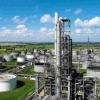Dear Sir
In the design of acrylic acid total condenser (horizontal) for the epoxy acrylate reactor, Acrylic acid (10%) and air (80%) in the tube side was cooled from 80 C
@0.5 kg/cm2g to 50 C@ 0.2 kg/cm2g by using cooling water (shell side
inlet = 30C@ 3kg/cm2g, and outlet = 40C @ 2.3kg/cm2g).
Cooling water which is usually more prone to fouling flow in the shell side, and
Acrylic acid vapor and gas (almost N2) flow in the tube side.
My question is following:
- Are the vertical or horizontal cut and the vent nozzle properly situated in HTRI critical for the result of HTRI or not? (There is already a vent line to waste gas flare in this total condenser, and indeed properly situated vent can prevent accumulation of non-condensable )
Also, the baffles are cut vertically for side to side flow (parallel-cut baffle); it will facilitate drainage of the condensate. However, the parallel-cut baffles have the potential for significant flow and temperature misdistribution in the end zones, which can induce local tube vibration and reduce the effective heat transfer rate in the inlet and outlet baffle spaces.
- Is TEMA type(BEM), and single segmental baffle proper for this case or not ? Single segmental baffle is operated well in single phase (if 2 phase case, which one is proper ?), and cross flow heat transfer (across the tube) is greater than
the longitudinal heat transfer ( through the windows). However, it may not be
effective with very viscous fluids. ( Is that means not proper condenser in the polymer plant ?)
Above is my silly question, and hope not bother you too much time.
Please kindly give me any comment or guide in this case.
Thank you so much.
Best regards,

 FB
FB













